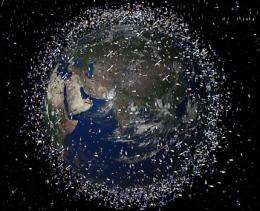August 12, 2011 report
Aerospace engineer proposes arm-equipped satellite to affix propellant kits to space junk to send it back home

(PhysOrg.com) -- Over the past several years, many scientists and armchair enthusiasts alike have offered up a possible solution to the ever growing cloud of space junk circling the Earth; the result of leftover missions, collisions and inadvertent accidents.
One such proposal even suggested a cloud of tungsten be sent up to coat the trash, causing it to grow heavy enough to fall to Earth.
Now, a more practical approach is being offered by Italian aerospace engineer Marco Castronuovo of the Agenzia Spaziale Italiana. In his paper, published in the journal Acta Astronautica he suggests that a satellite carrying among other things a solid propellant that could be affixed to a large piece of space junk, be launched. The satellite would have two robotic arms he says; one to grab hold of the piece of junk (say a spent rocket part) the other to affix the propellant device that once activated, would guide the piece of junk towards Earth, where it would burn up (hopefully) in the atmosphere.
Space junk is of growing concern to those who launch satellites and of course manned craft into space. Just last month evasive maneuvers had to be conducted to prevent the International Space Station from colliding with an object in its path. And while the amount already up there is of concern, what is even more troubling is the possibility of space and the debris up there falling prey to the Kessler Syndrome, a condition whereby pieces of space junk collide with one another, causing them to break into several smaller pieces. Those smaller pieces, because there would then be more of them would then have a greater chance of colliding with something else, thereby creating ever smaller pieces and on and on, until the number of minuscule pieces would total in the tens if not hundreds of millions of pieces, eventually creating such an inhospitable environment that functioning spacecraft couldn’t hope to survive.
Castronuovo says such a satellite as he proposes, would be capable of de-orbiting 35 large objects over a 7 year period, which would be more practical than it sounds because it would target the forty-one large rocket bodies that are currently orbiting in the sun-synchronous orbital region near the Earth, which he says is where most of the catastrophic collisions in the near term are likely to occur.
More information: Active space debris removal -- A preliminary mission analysis and design, Acta Astronautica, Article in Press. doi:10.1016/j.actaastro.2011.04.017
Abstract
The active removal of five to ten large objects per year from the low Earth orbit (LEO) region is the only way to prevent the debris collisions from cascading. Among the three orbital regions near the Earth where most catastrophic collisions are predicted to occur, the one corresponding to a sun-synchronous condition is considered the most relevant. Forty-one large rocket bodies orbiting in this belt have been identified as the priority targets for removal. As part of a more comprehensive system engineering solution, a space mission dedicated to the de-orbiting of five rocket bodies per year from this orbital regime has been designed. The selected concept of operations envisages the launch of a satellite carrying a number of de-orbiting devices, such as solid propellant kits. The satellite performs a rendezvous with an identified object and mates with it by means of a robotic arm. A de-orbiting device is attached to the object by means of a second robotic arm, the object is released and the device is activated. The spacecraft travels then to the next target. The present paper shows that an active debris removal mission capable of de-orbiting 35 large objects in 7 years is technically feasible, and the resulting propellant mass budget is compatible with many existing platforms.
© 2011 PhysOrg.com




















